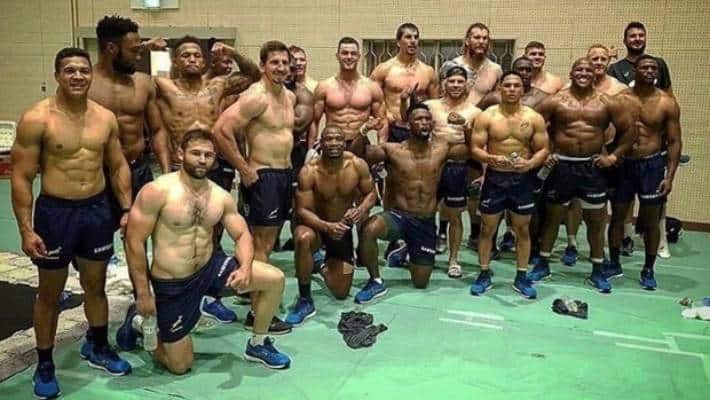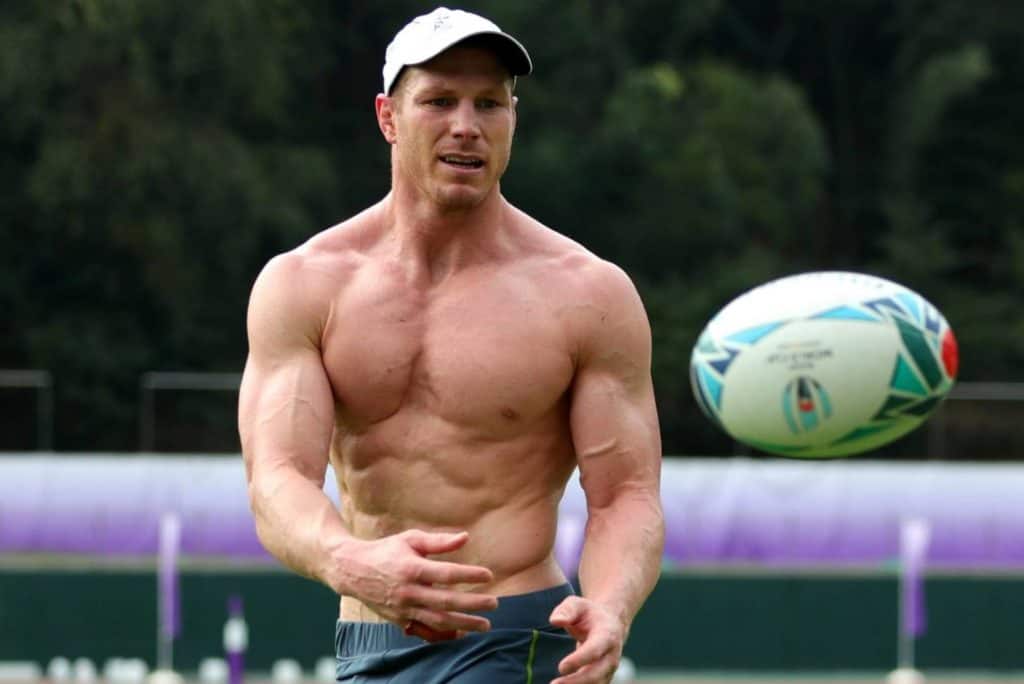
Everyone knows rugby players are big, strong and have rippling muscles. However, as the players wear shirts it is not clear what body fat percentage they have and whether or not they have defined abs to match their building biceps and muscular legs.
Do rugby players have six packs?
Many rugby players do have six packs. It is common for rugby backs to have six packs as they need to be fast and extra fat slows them down. Rugby backs typically have a body fat percentage in the 12% to 14% which is enough to show off their 6 packs. Most rugby forwards do not have six packs.
Six packs are a regular sight among rugby backs. Rugby backs are built closer to olympic sprinters than Sumo wrestlers. Rugby backs need to be big and strong but they also need to be quick, agile and have lightning quick acceleration when sprinting down the sideline, stepping around players or suddenly changing directions to pick up a ball.
To ensure rugby backs maintain these attributes they need to keep their body fat percentage low as any excess fat slows them down. As rugby backs have a low body fat percentage (12% to 14% is typical) combined with well developed bodies they often have visible abs and well defined six packs. How defined their 6 packs are depends on their muscle mass, genetics, body fat percentage and where they store their fat.
Unlike in the backline six packs are much less common amongst rugby forwards. While rugby forwards need to be quick and agile they need much higher levels of strength and size than backs.
To build strength and size you need to have a higher body fat percentage. There is a limit on how much muscle the human body can build and maintain without the use of steroids. Many rugby players have reached that limit so increase size they increase their body fat percentage.
The typical body fat percentage of a rugby forward is in the 15% to 22% range. Six packs are most common amongst loose forwards who tend to be towards the lower end of the typical body fat percentage range while they are virtually non existent among props who usually always have a body fat percentage over 18%.
While rugby forwards are incredibly strong and have huge amounts of muscle on average their body fat percentages are just too high for them to have clear six packs. Realistically the highest body fat percentage you can have and still have a highly visible six pack is 15% but typically an athlete will need to achieve a sub 12% body fat percentage.
Even though many rugby players do not have six packs all players have very strong and muscular cores. Whether or not you can see their abs comes down to how high their body fat percentage is.
To the casual observer it may appear that props are just overweight unconditioned athletes when in fact beneath those layers of fat they are holding incredibly high amounts of muscle and fat free mass. As the average prop has a body fat percentage in the 18% to 22% range their iron cores are hidden but trust me the core strength needed to scrum at a high level is immense.
How Do Rugby Players Get Six Packs?
Rugby players get six pack abs through developing their bodies and building muscle by lifting weights and following a nutrient and protein rich diet. They combine this muscle building training with a calorie deficit diet so they can lose body fat and achieve a low body fat percentage.

Rugby players get six pack abs through a combination of diet, training and genetics. It is possible for everyone to get a six pack but how easy it is for someone depends on your level of mass, your level of fat, where you store your fat and how your abs look.
Some rugby players are blessed with amazing genetics. Even if they have a body fat percentage that is much higher than you usually need to have a six pack they still have visible abs because they have large amounts of muscle and their body does not store as much fat in their stomach as other athletes.
To build their 6 packs rugby players first lift weights. Rugby players typically focus on big compound movements such as bench press, squat and deadlift. They supplement these movements with smaller bodybuilding exercises to develop specific muscle groups for example they might do bicep curls or tricep extensions to increase muscle mass in their arms.
Rugby players will also perform ab specific exercises. Sit ups and ab wheels are commonly performed by rugby athletes.
Rugby players will maximise their muscle growth by eating a calorie surplus which is made of high protein foods such as eggs, beef, chicken and fish. To fuel their workouts and ensure they are eating enough calories they will pair their protein with a high carb source such as rice, pasta and fruit.
After increasing their body weight rugby players will then start slowly decreasing their calories to shed their bodies of any excess fat which is an unavoidable by-product of gaining muscle. They will eat the same foods as when they were gaining weight but will decrease their carbs and the total calories they are consuming.
After following this diet the end result will be the rugby player will have a higher amount of muscle mass while also have a lower body fat percentage than when they first started trying to build muscle. If all goes well they will also be sporting a well defined core and six pack abs.
Conclusion
Six packs are common amongst rugby packs who need to have lower body fat percentages as excess fat reduces their sprinting ability and their agility. Six packs are not common amongst rugby forwards as they rely more on strength and size and have higher body fat percentages. However, all rugby athletes train their abs and have very strong cores.
To develop their six pack abs rugby players increase their muscle mass through lifting weights and following a protein rich diet. They then shed excess body fat by decreasing their calories. Once this process is complete rugby players have high enough muscle mass and low enough body fat percentages to display strong six pack abs.
